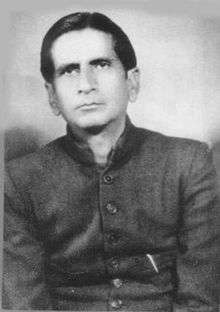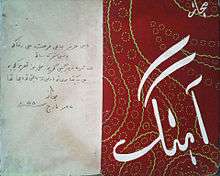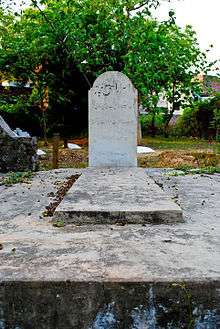Majaz
Asrar ul Haq Majaz Urdu: اسرارُالحق مجاز commonly known as Majaz Lakhnawi Urdu: مجاز لکھنَوی (19 October 1911 – 5 December 1955) was an Indian Urdu poet. He was known for his romantic and revolutionary poetry. He composed ghazals and nazms in Urdu.[1] He was the maternal uncle of poet and screenplay writer Javed Akhtar.
Majaz Lakhnawi | |
|---|---|
 | |
| Born | 19 October 1911 Rudauli, United Provinces of Agra and Oudh, British India |
| Died | 5 December 1955 (aged 44) Lucknow, Uttar Pradesh, India |
| Pen name | Majaz Lakhnawi |
| Occupation | Poet |
| Nationality | Indian |
| Genre | Ghazal, Nazm, Geet |
| Subject | Love, philosophy, Revolution |
Early life and education
Majaz was born on 19 October 1911 at Rudauli in Barabanki district of what is now Uttar Pradesh. His family were a branch of a land-owning gentry family, but were not wealthy. He was one of numerous children, but only three of his siblings reached adulthood, and among them, his only surviving brother died at age 18 in a freak accident, when Majaz was only nine. After that, Majaz became the only son of his family, and he had two older sisters, namely Safia and Hamida. Safia was the wife of poet Jan Nisar Akhtar. Thus, Majaz was the maternal uncle of Javed Akhtar. Majaz suffered from a hearing impairment even as a child, and probably for this reason, he tended to be somewhat difficult, with erratic behavior; he was moody and also a loner. He had the habit of staying awake all night and doing most of his work then; as a result, his earned the nickname "Jaggan" ("awake" in Hindi).
Majaz's father, Seraj-ul-Haq, was a university graduate at a time when this was rare; he joined government service, serving in the middle ranks of the registration department, and finally reached the rank of Assistant Registrar. He was posted mainly in Lucknow, but since his aged parents needed attention, he kept his wife and children in the ancestral house at Rudauli, which is not far from Lucknow, and he would visit them about twice a month. Thus, Majaz grew up mainly in Rudauli and received his basic education there. In the late 1920s, his father was transferred to Agra. Since his parents were no more, and since Agra was too far from Rudauli for frequent visits, Seraj-ul-haq decided to take his wife and children with him. Majaz completed school in Agra in 1929, and enrolled in St. John's Intermediate College. Almost immediately, his father was transferred to Aligarh, and the family moved again, leaving Majaz in a hostel. The young Majaz was given a cash allowance for the first time in his life, and freedom from his mother's eagle surveillance. He behaved like any teenager of his age, neglected his studies, spent his time and money the way he liked, and failed his exams. Yet, his time was spent not on games or in disreputable activities, but in attending mushairas (poetry symposia) and music concerts. It was at this time that he came in contact with both senior and upcoming poets of Agra, including Fani Badayuni, Al-e-Ahmed Suroor and Jazbi. With difficulty, Majaz finally cleared his intermediate exams in 1931, and rejoined his parent in Aligarh, where his father got him enrolled for BA at Aligarh Muslim University, his subjects being philosophy, economics and Urdu. He graduated in 1935, again taking an year more than he should have. He then enrolled for an MA in the same university, but was not serious about it, and never completed it.
Career

The years that Majaz spent in Aligarh Muslim University coincided with the presence there of many important poets and writers of Urdu. AMU was indeed a nursery of literary talent during those years. Majaz lived and wrote in times which were exceptionally vibrant for poetry; poets such as Faiz Ahmed Faiz, Fani Badayuni, Jazbi, Makhdoom and Ali Sardar Jafri were among his peers. They were not merely his contemporaries but closest friends. Others such as Josh and Firaq knew him well. His first diwan, Ahang, is dedicated to Faiz and Jazbi whom he calls his “dil-o-jigar,” and to Sardar Jafri and Makhdoom, who are “mere dast-o-bazu.” Faiz wrote a thoughtful dibacha to Ahang.[2]

Major works
- Shab-e-taab
- Aahang
- Saaz-e-Nau
- Tarana Aligarh Muslim university Aligarh
Honours
- In memory of the legendary Urdu poet Asrarul Haq Majaaz (1913–54) a Book Launch : Majaz Aur Uski Shaayeri Edited by Salman Akhtar was held in collaboration with The Nehru Centre, London and Aligarh Muslim University Alumni Association (UK). The programme included video clippings on Majaz including comments by Hamida Salim (Majaz's sister) and Ali Sardar Jafri (Majaaz's friend and contemporary poet), the launch of collection of articles on Majaaz edited by Salman Akhtar (Star Publications, New Delhi), a talk, Majaaz Aur Uski Shaayeri, by Parvaiz Alam, Broadcaster and dramatist, a talk, Majaz – Teen Daayeron ka Shayer by Dr Salman Akhtar, the US based Psychiatrist, Urdu Poet and Majaz's nephew and Kalam-e-Majaz sung by Nasser Harvani and Majaz's nephew from New Delhi.[3]
- Book on Majaz Aur Uski Shaayeri Edited by Salman Akhtar[4]
- A dastangoi based on Majaz's life and poetry was performed by Ankit Chadha and Himanshu Bajpai[5] This narrative introduces the audience to Majaz, his childhood, his fame at AMU, his days in Delhi, his love, his poetry and most importantly his aawaargi.[6] The story was told through accounts of the poet's relatives, friends and acquaintances.[7]
References
- A time for poetry | Sports | thenews.com.pk | Karachi. thenews.com.pk (26 December 2010). Retrieved on 2018-11-13.
- Column: The lonely poet: Majaz – Newspaper. Dawn.Com (14 July 2013). Retrieved on 2018-11-13.
- "Archived copy". Archived from the original on 21 February 2014. Retrieved 17 January 2014.CS1 maint: archived copy as title (link)
- Majaz Aur Uski Shayari. Star publications, New Dekhi. 2012. ISBN 9788176505284.
- नई दास्तान, नया दास्तानगो!. Tehelka Hindi (19 November 2014). Retrieved on 2018-11-13.
- Farzand Ahmed (27 October 2014) . shahernama.com
- Dastangoi returns home to Lucknow. Times of India (19 October 2014). Retrieved on 2018-11-13.
External links
| Wikimedia Commons has media related to Majaz. |